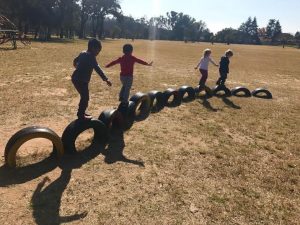 Nature based schools are gaining great interest with modern, working parents. This trend has grown over 800 percent since 2012. Nature based preschools with daily exposure to nature has proven to be a vital element in early education for young children. Our Montessori preschool positioned in a beautiful, tranquil, country setting, with weekly nature walks, brings our children much joy! Guess what? Last week we noticed two white eyed owls in the school parking lot!
Nature based schools are gaining great interest with modern, working parents. This trend has grown over 800 percent since 2012. Nature based preschools with daily exposure to nature has proven to be a vital element in early education for young children. Our Montessori preschool positioned in a beautiful, tranquil, country setting, with weekly nature walks, brings our children much joy! Guess what? Last week we noticed two white eyed owls in the school parking lot!
The extract below is written by Danielle Cohem
Why Do Children Need to Spend Time in Nature?
They may prefer to stick to their screens, but here’s why getting outdoors matters.
In the early 1980s, a Harvard University biologist named Edward O. Wilson proposed a theory called biophilia: that humans are instinctively drawn towards their natural surroundings. Many 21st century parents, however, would question this theory, as they watch their kids express a clear preference for sitting on a couch in front of a screen over playing outside.
The national panic about kids spending too much time indoors has become so extreme that the crisis has a name: Nature deficit disorder.
While calling it a disorder might be merely rhetorical, it’s clear kids spend significantly more time inside than outside. This shift is largely due to technology: The average American child is said to spend 4 to 7 minutes a day in unstructured play outdoors, and over 7 hours a day in front of a screen.
Richard Louv, author of the book Last Child in the Woods: Saving Our Children From Nature-Deficit Disorder, tells the story of interviewing a child who told him that he liked playing indoors more than outdoors “cause that’s where all the electrical outlets are.”
Increasing parental fears about diseases and dangers of playing outside—despite evidence to the contrary—are another big factor.
And as suburbs and exurbs continue to expand, nature is parcelled off more, and kids seem less inclined to spend time in a fenced-in yard, let alone jump the fence into a neighbour’s or walk in the woods. Instead, indoor activities can seem easier (no sunscreen necessary!), safer, and even more sociable for kids who are growing up with multiplayer video games and social media accounts.
Why go outside?
 Recent studies have exposed the benefit—even necessity—of spending time outdoors, both for kids and adults. Some argue that it can be any outdoor environment. Some claim it has to be a “green” environment—one with trees and leaves. Others still have shown that just a picture of greenery can benefit mental health. These nuances aside, most of the studies agree that kids who play outside are smarter, happier, more attentive, and less anxious than kids who spend more time indoors. While it’s unclear how exactly the cognitive functioning and mood improvements occur, there are a few things we do know about why nature is good for kids’ minds.
Recent studies have exposed the benefit—even necessity—of spending time outdoors, both for kids and adults. Some argue that it can be any outdoor environment. Some claim it has to be a “green” environment—one with trees and leaves. Others still have shown that just a picture of greenery can benefit mental health. These nuances aside, most of the studies agree that kids who play outside are smarter, happier, more attentive, and less anxious than kids who spend more time indoors. While it’s unclear how exactly the cognitive functioning and mood improvements occur, there are a few things we do know about why nature is good for kids’ minds.
- It builds confidence. The way that kids play in nature has a lot less structure than most types of indoor play. There are infinite ways to interact with outdoor environments, from the backyard to the park to the local hiking trail or lake, and letting your child choose how he treats nature means he has the power to control his own actions.
- It promotes creativity and imagination. This unstructured style of play also allows kids to interact meaningfully with their surroundings. They can think more freely, design their own activities, and approach the world in inventive ways.
- It teaches responsibility. Living things die if mistreated or not taken care of properly, and entrusting a child to take care of the living parts of their environment means they’ll learn what happens when they forget to water a plant, or pull a flower out by its roots.
- It provides different stimulation. Nature may seem less stimulating than your son’s violent video game, but in reality, it activates more senses—you can see, hear, smell, and touch outdoor environments. “As the young spend less and less of their lives in natural surroundings, their senses narrow,” Louv warns, “and this reduces the richness of human experience.”
 It gets kids moving. Most ways of interacting with nature involve more exercise than sitting on the couch. Your kid doesn’t have to be joining the local soccer team or riding a bike through the park—even a walk will get her blood pumping. Not only is exercise good for kids’ bodies, but it seems to make them more focused, which is especially beneficial for kids with ADHD.
It gets kids moving. Most ways of interacting with nature involve more exercise than sitting on the couch. Your kid doesn’t have to be joining the local soccer team or riding a bike through the park—even a walk will get her blood pumping. Not only is exercise good for kids’ bodies, but it seems to make them more focused, which is especially beneficial for kids with ADHD.- It makes them think. Louv says that nature creates a unique sense of wonder for kids that no other environment can provide. The phenomena that occur naturally in backyards and parks everyday make kids ask questions about the earth and the life that it supports.
- It reduces stress and fatigue. According to the Attention Restoration Theory, urban environments require what’s called directed attention, which forces us to ignore distractions and exhausts our brains. In natural environments, we practice an effortless type of attention known as soft fascination that creates feelings of pleasure, not fatigue.
So while screen time is the easier, more popular choice, it’s important to set aside time for outdoor play. For fun, stimulating activities you and your kids can do in nature, see Ideas for Getting Your Kids into Nature.
The pictures in this post are in our school surroundings at Fields Montessori. Find out more about this school in Parkmore, Sandton, Johannesburg on the website.


